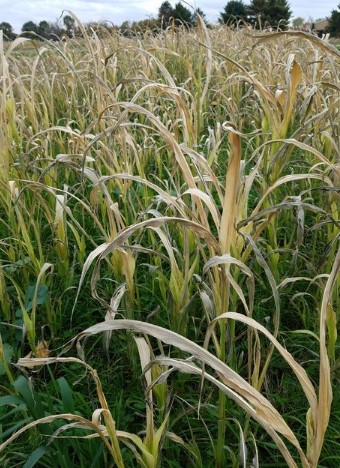By Kim Cassida
Forage sorghum, sudangrass, and sorghum-sudangrass hybrids (sudex) are exceptionally heat and drought tolerant annual crops that are used as cover crops, pasture, hay, and silage. Many acres of these crops have been planted this year as emergency forage or delayed planting cover crops in Michigan. However, care is needed when utilizing these forages for cattle, sheep and goats during frosty weather because of risks related to prussic acid poisoning.

All plants in the sorghum family can cause prussic acid poisoning in livestock. Forage sorghum has the greatest toxicity potential and sudangrass the least, with hybrid sudex intermediate. Prussic acid is also called hydrocyanic acid, otherwise known as cyanide. Poisoning occurs when enzymes naturally present in the plant tissue convert a secondary compound called dhurrin into toxic cyanide gas whenever the plant wilts. Therefore, producers grazing sorghum-family forages must be alert to any conditions that cause sudden wilting of the forage. Potentially dangerous wilting can be caused by frost, drought, cutting, chopping, trampling, or even just by chewing. Rumen bacteria can detoxify some prussic acid if animals are gradually introduced to
the forage and are not consuming prussic acid at a rate faster than it can be broken down. Death can still occur in livestock used to sorghum if prussic acid levels spike due to frost or if hungry animals eat a sudden large dose of toxic forage. Toxicity potential is greatest in seedlings, lush dark green new leaves, frosted forage, and drought-wilted forage. High levels of soil N fertility and low fertility of P and K can increase toxicity. Leaves contain more toxin than stems. Because of the concentration of cyanide in new leaves, sorghum forages should never be grazed or fed as green chop until plants are at least 18 to 24 inches tall. This is approximately belly high on a mature cow.
Prussic acid poisoning is a veterinary emergency. Signs can occur as soon as ten minutes after consuming a toxic dose. Cyanide interferes with the ability of blood to carry oxygen, causing animals to die of suffocation. Affected animals show labored breathing, excitement, gasping, convulsions, paralysis, staggering and death. Usually animals are simply found dead because progression is rapid and easily missed when animals are not under continuous observation.
The period of time between first light frost and killing frost is exceptionally dangerous because it is difficult to predict exactly how much cyanide may be present. Do not feed frosted sorghums as green chop. Do not graze sorghum-family forages or cover crop mixes containing them on nights when the first frost is expected. After the first frost, new shoots may sprout from partially frost-injured plants if there is a warm spell, and this new growth can be dangerously high in prussic acid. Therefore, the safest strategy is to keep livestock off pastures containing sorghums from the first light frost until the plants are completely dead and dry after a killing frost. Sorghum forage is usually safely dry within 5 to 7 days after a killing frost.
Frosted sorghum forages are usually safe to harvest as hay, silage, or baleage. Cyanide gas dissipates during the hay curing phase and during handling and feedout of silage. Sorghum and sudangrass hays are therefore safe to feed once bales are completely cured, which takes about three weeks. Silage and baleage are safe to feed after fermentation is complete, which takes about 6 to 8 weeks after ensiling. Cyanide gas is heavier than air and can accumulate in low, poorly ventilated areas. If storing sorghum silage in upright silos or bunkers, take the same precautions that apply to toxic silo gases for any crop. Ventilate the feed room and use caution if entering the silo.
Sorghum-family forages can be used safely if producers pay attention to reduce the risks.
Source : msu.edu